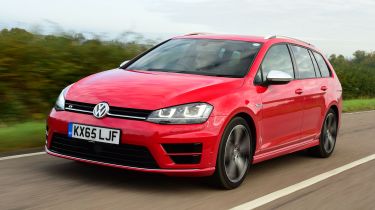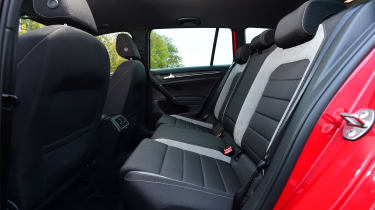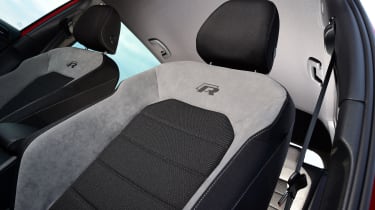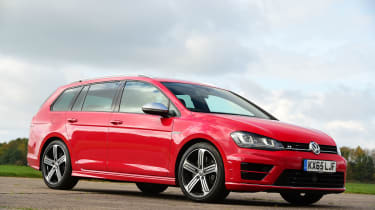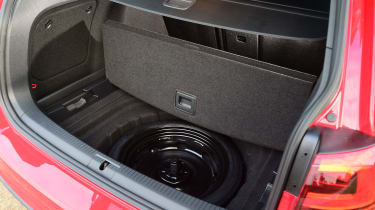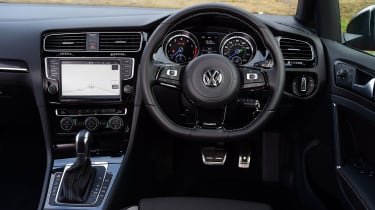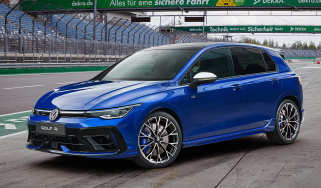Volkswagen Golf R Estate (2015-2020)
“If you want performance, practicality and decent running costs all at the same time, then it’s hard to overlook the Volkswagen Golf R Estate”
Pros
- Performance and practicality in one
- Entertaining to drive
- Tons of grip
Cons
- Expensive to buy
- Understated design
- Only available as an automatic
The high-performance estate car class is a pretty narrow niche, but includes some impressive cars. Volkswagen’s Golf R Estate is the German company’s take on the concept, blending the versatility of the Golf Estate with the rocketship power of the Golf R hatchback, which we’ve reviewed separately. It goes up against rivals like the SEAT Leon ST Cupra 300 and Skoda Octavia vRS Estate.
Many sporty-looking estate cars are more about style than substance, but like its hatchback sister, the Golf R Estate gets a 306bhp version of Volkswagen’s proven turbocharged 2.0-litre petrol engine. It’ll do the 0-62mph sprint in just 4.8 seconds and go on to an electronically limited 155mph top speed, if it's safe and legal to do so. That figure increases to 168mph if you add the optional Performance Pack, which also includes a brake upgrade and a set of special 19-inch alloy wheels.
The Golf R Estate is four-wheel-drive only and only available with a six-speed dual-clutch automatic gearbox, whereas the hatchback offers a manual option. There’s not much difference in the way the R Estate drives compared to the hatchback, only the slight increase in weight takes the edge off the steering’s sharpness.
The SEAT is the closest to the Volkswagen in terms of performance, while the Skoda is by far and away the most practical of the bunch but the VW is likely to hold on to more of its value secondhand than the others.
More reviews
Car trim reviews
In-depth reviews
- Volkswagen Golf R review – the ultimate hot Golf
- Volkswagen Golf review - the go-to family hatchback
- Volkswagen Golf R estate review
Used car reviews
Apart from a smart set of roof rails and the extra length for the bigger boot – which offers 605 litres of luggage space and can be extended to 1,620 litres if you fold the rear seats down – the estate looks much the same as the hatchback. The R is distinguished by its distinctive front bumper treatment, LED headlamps and unique alloy wheels, while the interior features the usual high-quality construction that the Golf is renowned for.
The standard Volkswagen Golf finished 18th out of the 75 cars ranked in our 2017 Driver Power owner satisfaction survey of cars currently on sale in the UK.
MPG, running costs & CO2
When you take the Golf R Estate’s performance and power into consideration, its modest fuel economy begins to look more reasonable. The 2.0-litre turbocharged engine produces 306bhp and drives all four wheels through a dual-clutch automatic gearbox – yet still returns 39.2mpg.
That’s only around one mile per gallon less efficient than the slower and less powerful 2.0-litre turbocharged Ford Focus ST Estate, while the the SEAT Leon ST Cupra, which shares some mechanical components with the Golf R Estate, also returns around the same figure.
CO2 emissions stand at 164g/km, which translates to £180 a year on road tax under the current system. However, cars registered on or after 1 April 2017, when new Vehicle Excise Duty (VED) rules take effect, will face a lower yearly charge of £140.
Engines, drive & performance
Central to the appeal of the Golf R Estate is a 2.0-litre turbocharged petrol engine that produces a hefty 306bhp. Couple that to a slick six-speed DSG dual-clutch automatic transmission (the only available gearbox) and an intelligent four-wheel-drive system and you get one of the easiest performance cars on the market to drive.
As demonstrated by the excellent SEAT Leon ST Cupra, VW Group engineers appear to have developed a knack for maintaining performance and driving thrills in the transition from hatchbacks to bulkier estates. Even the increased weight of the estate compared to the hatchback does little to dull the driving experience the Golf R Estate offers.
The car’s driver profile system has a ‘race’ mode, which disengages the traction control. The hot estate has loads of grip and its 0-62mph time stands at 4.8 seconds – a whole second quicker than the Leon ST Cupra and only two tenths slower than the DSG-equipped Golf R hatchback.
If you want still more speed than the R estate's 155mph capability, the optional Performance Pack includes de-restriction to a massive 168mph. The pack also incorporates upgraded brakes claimed to provide additional feel. These are concealed behind a special set of 19-inch alloy wheels.
Interior & comfort
The Golf R Estate’s interior is typical Volkswagen: classy, well appointed and solidly built. Given the fact that the R is technically the top-spec Golf Estate, it’s also full to the brim with standard equipment. Not only are buyers treated to the ‘R’ Styling package, which smartens up the exterior with discreet styling cues, they also get all-round parking sensors, bright bi-xenon headlights, cruise control, climate control and heated front seats. You also get a neat electronic instrument cluster that can be configured to show exactly the information you want to see.
The standard Discover infotainment system uses an eight-inch colour touchscreen and offers Apple CarPlay and Android Auto smartphone connectivity. Interior materials are all high-grade and there’s no evidence of cost-cutting, even in places you’d expect like below your knee in the footwells. Optional adaptive dampers allow you to select driving modes that range from ‘comfort’ to ‘race’, with every selection feeling significantly different. We’d highly recommend the dampers, as they help turn what is already a very good driver’s car into a great one
Practicality & boot space
The Golf R Estate’s extended frame brings a massive jump in boot space compared to the hatchback. The boot is now capable of carrying 605 litres of your groceries or travel bags, and if you fold the seats down, the boot space jumps to a cavernous 1,620 litres in total.
Unlike the Golf R hatchback, where the four-wheel-drive mechanism detracts from boot space, the estate offers the same load capacity as its two-wheel drive counterparts. There’s room in the back for three adults to sit – although the middle passenger gets a raw deal, as the a transmission tunnel eats into legroom. There are plenty of storage spaces dotted around the cabin. There’s no lip on the boot and a welcome lack of wheelarch intrusion, too, so carrying large items won’t prove too much of an issue.
Reliability & safety
The sharing of parts between VW Group brands means all of the important bits of the Golf R have been tried and tested across the range. The standard Volkswagen Golf was rated highly for reliability in our 2017 Driver Power owner satisfaction survey of cars currently on sale in the UK. Of the owners who responded, 15.6% reported experiencing a problem with their car at least once.
Euro NCAP awarded the latest generation of Golf the full five-star rating when it was crash-tested and reported good protection in almost every area. The Golf R Estate is also fitted with an autonomous emergency braking system that can automatically bring the car safely to a halt if a hazard is detected in its path.
Price, value for money & options
The Golf R Estate is priced from around £35,000, which is about £3,000 more than the hatchback version. The amount of equipment included as standard and the 307mm of extra car attached to the rear help to justify the extra expense over the hatchback, but some may still be put off by the estate’s high asking price.
Perhaps the most exciting option available is the £2,300 Performance Pack, which includes special 19-inch alloy wheels, a derestricted 168mph top speed and, appropriately, an upgraded brake system. Other tempting options include keyless entry for £360, a rear-view camera for £165 and the Tech Pack, which adds sat nav and a Dynaudio Excite stereo for £1,240.
Also available is a larger 9.2-inch Discover Pro infotainment system – we like its crisp, clear graphics, but are less keen on its gesture-recognition system. This aims to make navigating the menus easier through gesticulations rather than button-presses, but we found it rather unintuitive.
Resale values for any Golf in the range are strong and the R model should be no different, especially due to its added rarity.

